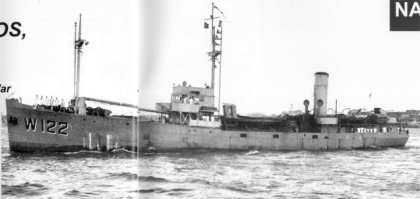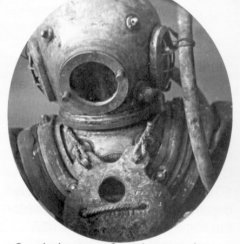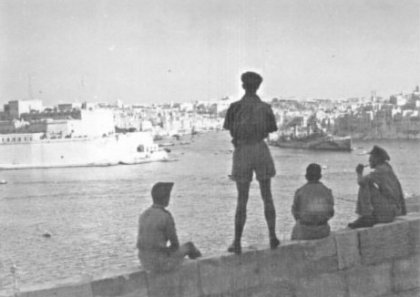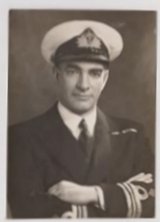

 The South African
The South African
On the evening of 18 December 1941, the Italian submarine, Scire, operating a short distance off Alexandria Harbour, Egypt, in the Mediterranean, successfully launched three electrically-driven human torpedoes of the 10th Light Flotilla, each manned by a crew of two seated across the torpedo. In the early hours of 19 December, the human torpedoes, nearing Alexandria, followed in the wake of HMS Harrow. This was the last vessel in a fleet of minesweepers commanded by Lieutenant L A J Keeble, RNVR (SA), which was entering Alexandria Harbour. The human torpedoes entered the naval base, undetected, and attached mines to a large oil tanker and a destroyer. They positioned the warheads of the torpedoes under HMS Queen Elizabeth and HMS Valiant.
Out of oxygen, the Italians surrendered. One was taken on board the HMS Valiant and, after interrogation, was locked in the bowels of the battleship. Some time later, the desperate prisoner pleaded to see the Captain. He revealed the fact that the HMS Valiant would be hit by violent explosions. Acting on his words, the Captain ordered the lower decks to be cleared to avoid unnecessary casualties. Huge explosions rocked the Harbour, severely damaging the battleships. The HMS Queen Elizabeth suffered a 2,3m hole in the hull, and the HMS Valiant, an 18m long tear in the bow. Both ships sank on an even keel to the shallow, muddy bottom of the Harbour. Viewed from the air the next day, they appeared to be resting at ease at anchor.
With the loss of the HMS Prince of Wales and HMS Repulse in the Far East, Britain had lost four battleships within the space of ten days, leaving her without a capital ship in those areas. A survey established that salvage of the ships would be possible, but not without great difficulty.
Admiral Cunningham, Commander-in-Chief of the Mediterranean theatre of operations, aware that Lieutenant Keeble was familiar with salvage work, sent him to the headquarters of the South African Engineer Corps (SAEC) in Cairo to brief the South African engineers on the critical situation that had developed at Alexandria, and to request their urgent help in the salvaging work. Three fully-equipped divers of the 41st South African Harbour Construction Company, SAEC, working on harbour improvements at Marakeb Harbour, were despatched to help with the Alexandria salvage operations.
In the meantime, Lieutenant Keeble was flown to Cape Town to deliver a special message from Admiral Cunningham to General Smuts, imploring him to send salvaging teams to Alexandria Harbour. In response, four South African Railways & Harbours Brigade divers and a petty officer diver from the Seaward Defence Force (SDF), were flown 'up North', arriving at Alexandria on 7 January 1942.
For the next three months, the South African divers, facing many known and unknown hazards in the muddy waters of Alexandria Harbour, used gas and electric cutting equipment to remove the jungle of twisted steel from the vessels and then patched the holes by welding plates across them to seal the hulls so that the ships could be filled with compressed air, raised and moved to the dry docks for repairs.

Her war work done, the HMSAS Gamtoos leaves Alexandria Harbour
to return to the Union of South Africa. (Photo: By courtesy, SANMMH).
Admiral Cunningham was pleased with the effort, referring to it as 'a wonderful job'. Aware of the expertise of the South Africans, he urgently requested General Smuts to construct a salvage vessel, under the control of the SDF, which could assist the Marine Salvage Force in the Mediterranean. The survey of the Gamtoos, a 750-ton coaster with a shallow draught, built in 1936 by Scott & Sons, Bowling, Glasgow, led to its selection for conversion to a salvage vessel. It was requisitioned by the SDF and purchased in full from Smith's Coasters of Durban.
The Gamtoos sailed for East London on 10 June 1942 and was handed over to Messrs Alpheus, Williams and Dawse Ltd, for the conversion, which included the fitting out of large workshops, machinery and auxiliaries needed for salvage work. The armaments included one 12-pounder HNLA gun and two 20mm Oerlikons.
Completed by October 1942, HMSAS Gamtoos, pennant number W122, with a crew of eight officers and 47 other ranks, was commissioned by Lt Cdr R D Cruikshank at East London on 10 October 1942 and immediately departed for Durban to prepare for the voyage to North Africa. On board were nineteen Coloured naval personnel, the first non-white servicemen to serve in an active theatre of war with the South African Naval Forces, a new organisation formed on 1 August 1942 by the amalgamation of the Royal Naval Volunteer Reserve (South Africa) and the SDF.
The HMSAS Gamtoos sailed from Durban on 19 November 1942 to join the Marine Salvage Force in the Mediterranean, calling at Mombasa, Aden, and Port Suez, and arriving at Port Said on 21 December 1942. Her first task was to undertake the salvage of HMS Antwerp and HMS Malis, a job completed by 6 January 1943. This practical experience of salvage work instilled much confidence in the crew. Sailing for Alexandria on the day after completion, the HMSAS Gamtoos entered a theatre of war which the Allies were beginning to dominate. The harbours along the desert coastline were hazardous; their approaches were obstructed by blockship, mines, booby-traps, wreckage and other debris which prevented entry or evacuation. Salvage ships were called in to clear them and to restore the passage of supply ships and other vessels into them.
While in Alexandria Harbour, the HMSAS Gamtoos underwent maintenance and storing until 17 January, when she sailed westwards, meeting up with the supply ships of the Off-Shore Fleet which were following the advance of the British Eighth Army, to reach Benghazi on 21 January. Then she went on to Tripoli, meeting up with the South African minesweeper, HMSAS Boksburg, amongst others. Learning that the Eighth Army had entered Tripoli, the minesweepers cleared a channel to allow HMSAS Gamtoos to enter the harbour, which she did on 26 January 1943, settling next to the blockship, SS Ngoma.
Bad weather over the next few days delayed work, but with tremendous effort a passage was cleared in a week to allow the first two supply ships through to berth with supplies for the Eighth Army. A very pleased General Bernard Montgomery sent the following message to the HMSAS Gamtoos:
'I congratulate you and all concerned in the great achievement of opening Tripoli Harbour to the 8th Army supplies. Today is the date by which you stated a depth of 25 feet (7,62m)would be reached. You have in the intervening period progressed the work at a greater rate than I expected and the supplying of the 8th Army has benefitted accordingly. Well done!'
A delighted Sir Winston Churchill also congratulated the HMSAS Gamtooson her achievements and, when visiting Tripoli, personally paid a visit to the salvage ship to address the crew, even giving them autographs!
While in Tripoli, the HMSAS Gamtoos was kept busy salvaging a destroyer, HMS Derwent, facing constant air raids and experiencing several near-mine incidents and a narrow escape when the Ocean Voyager, fully laden with ammunition, blew up close by. Other ships that were salvaged were the Giovanni Battista, the Ocean Strength, and the HMS Prince Albert. A hole in the hull of the captured Italian battleship, the Italia, was also patched. During March 1943, the salvaging of a circling torpedo was the most nerve-wracking experience.
The HMSAS Gamtoos returned to Alexandria for an essential refit during September 1943. On 10 June, changes in command had seen Lt Cdr Cruikshank relieved by Lt Cdr Graham, who was later succeeded by Lt Cdr O'Brien. O'Brien commissioned the HMS Salvestor, a newly-built salvage ship with a South African crew. On 4 October, the HMSAS Gamtoos arrived at Tobruk Harbourto salvage the SS Delos and the Corona. Many other salvages followed along the North African coastline before the South African salvage vessel returned again to Alexandria for dry docking and storing. On 10 April 1944, she sailed again, continuing her salvaging work until August 1944, when she was transferred to Naples, Italy. By then, Lt Cdr Biermann (later Vice Admiral, CM, SA Navy) had taken over command.

Porthole view of a submerged South African diver at work
(Photo: SANMMH).
During the Italian Campaign, the HMSAS Gamtoos was employed in clearing a number of the invasion ports and, again, luckily escaped damage and casualties when an aircraft crashed onto her, her windlass falling alongside and blowing up. Making slow progress in heavy weather, the Gamtoos arrived at Marseilles on 3 September, some time after the Allied landing in the south of France. Finding the harbour strewn with wreckage and mines, and a sunken liner, the Cap Corse obstructing the entrance to Vieux Port, she set to work. The liner could not be moved intact, so it was broken apart by blasting and the debris dumped in deeper water. The blasting detonated a mine on her portside, but the Gamtoos fortunately escaped without casualties. Despite this setback, a passage was created by 12 September 1944, allowing Allied shipping to enter the port, a feat considered to be comparable to the achievement at Tripoli.
While entering the cleared harbour, an officer on the dockside hailed Lt Cdr Biermann, warning him that the Gamtoos was on top of a mine. Biermann immediately summoned the crew to the upper deck and, in what he described as the most tense moment that he faced in his naval career, he gently edged the ship away from the danger.
With her reputation well established, the Gamtoos went on to salvage the Sidi Aissa, towing it away to clear the valuable graving dock at La-Ciotat by 14 December 1944. This success earned Lt Cdr Biermann the OBE (Order of the British Empire), an honour he shared with the entire ship's company. Active salvaging work continued. On 25 February 1945, the ship proceeded to Ajaccio in Corsica to attend to the wreck of SS Corfirth. Thereafter, she sailed to Naples and then onto Malta, where she salvaged the destroyer, HMS Maori. While at Malta, the ship's mascot, an East African monkey named Chico, had to be put down after suffering severe shell-shock and was replaced by a dog named Whaghett.
The HMSAS Gamtoos was then sent off to Genoa to break up the enemy tanker, Sterope, in order to clear the entrance of the harbour, whereafter she was kept busy clearing many submerged craft blocking the inner harbour. After completing the arduous salvage operations at Genoa, the Gamtoos returned to Malta to salvage the MV King Edwin and the MV Talabot, her last salvaging task in the Mediterranean, which she completed by late 1945. Then, for the HMSAS Gamtoos, the war was over. She was free to go home.

Malta Harbour during the war (Photo: By courtesy, SANMMH)
The HMSAS Gamtoos had served in the war, not as a fighting vessel, but as a salvager. Her battles involved using ingenuity to solve particular challenges and facing unknown hazards while clearing gateways into blocked harbours so that supplies could reach the fighting forces. In a message to all ships in the Mediterranean, Admiral Cunningham, Commander-in-Chief, stated:
'I have noted the work performed by the warships of the Union of South Africa with admiration. These small ships have done splendid work, which has necessarily been of an unobtrusive nature. They have been most ably handled, and fraught with determination in numerous engagements and proved themselves a particularly valuable addition to my forces in the Mediterranean.'
Leaving Malta, the HMSAS Gamtoos called at Alexandria to take leave of the Mediterranean Naval Forces. She arrived at Durban on 11 December 1945 and then sailed on to Cape Town. In December 1947 and the following January, she was chartered as a storeship during 'Operation Snoektown' to transport mixed cargoes to Marion and Prince Edward islands, which had been annexed by parties from the HMSAS Transvaal on behalf of the South African Government. Some time later, she was transferred to the Department of Agriculture and Forestry to transport guano from the West Coast islands to the mainland. Sadly, it was almost with indignity that this fine old ship, at 43 years of age, reached the end of her life. In mid-1976, she was towed into Table Bay by SAS President Kruger to be scuttled by depth-charges. The tow-line parted, causing the failure of the first attempt at the scuttling of the Gamtoos. A second attempt - rocket attacks and bombing by Buccaneer aircraft of 24 Squadron, South African Air Force - also failed to send the defiant Gamtoos to the bottom of the bay. Shackletons of 35 Squadron, SMF, were then called in to depth-charge the ship and, finally, at last light on 10 June 1976, the Gamtoos slipped into the sea, the waves washing over the decks upon which many notable dignitaries had once walked.
Bibliography
Carter, Sub-Lt C E, Recording Officer, SANF, 'South Africa's Little Ships in the War at Sea', published in The Star newspaper.
Commando, Vol 8 No 3, March 1957, Naval Issue.
Du Toit, Alan, South Africa's Fighting Ships (Ashanti Publishing, Rivonia, 1992).
Fell, Capt W R, The Sea our Shield (Cassell & Co, London, 1966).
Harris, C J, War at Sea (Ashanti Publishing, Rivonia, 1990).
Marsh, John H, No pathway here (Howard Timmins, Cape Town, 1948).
Masters, David, Epics of Salvage (Cassell & Co Ltd, London, 1953).
Orpen, Neil and Martin, H J, Salute the Sappers, SA Forces in World War II, Volume 8, Part I (Sapper Assoc, Johannesburg).
The Rand Daily Mail, 'The Union's Naval Forces in Italian and Adriatic Campaigns'.
The Sailor, September/October 1944, 'South Africa's youngest armed force looks ahead.'
The Sailor, Vol 7, No 2, February 1949.
Turpin, Lt Cdr E W, 'Stories of the Little Ships' in Flotsam and Jetsam - Journal of the Ships Society of South Africa.

Thomas Francis O'Brien taken in Alexandria

Lt Cdr O'Brien with his officers on the Gamtoos
On 4th August 2025 the following comments were received from Bruce Dyer:
After the war she entered the employ as a supply ship for the Union Government Guano Islands of the Department of Trade and Industry. The name given is a post 1994 Government portfolio. She worked along the Southern African coast from Walvis Bay to Algoa Bay providing supplies of food, water and stores to the occupied islands and to the islands that had lighthouses. She also undertook several voyages to Marion Island in the 1950's, but notably for the Annexation of them in 1947/48 in Operation Snoektown.
I worked on the offshore islands and at Marion Island for 43 years. SS Gamtoos also moved tons of supplies and furniture for the Lighthouses at Dassen Island and Bird Island in Algoa Bay while on her runs to those and other sites. A Senior Inspector of UGGI, Dennis Price, kept diaries which I typed out and his industrious efforts keeping things in order give wonderful insights to that way of life from 1938 to 1972.
Return to Journal Index OR Society's Home page
South African Military History Society / scribe@samilitaryhistory.org